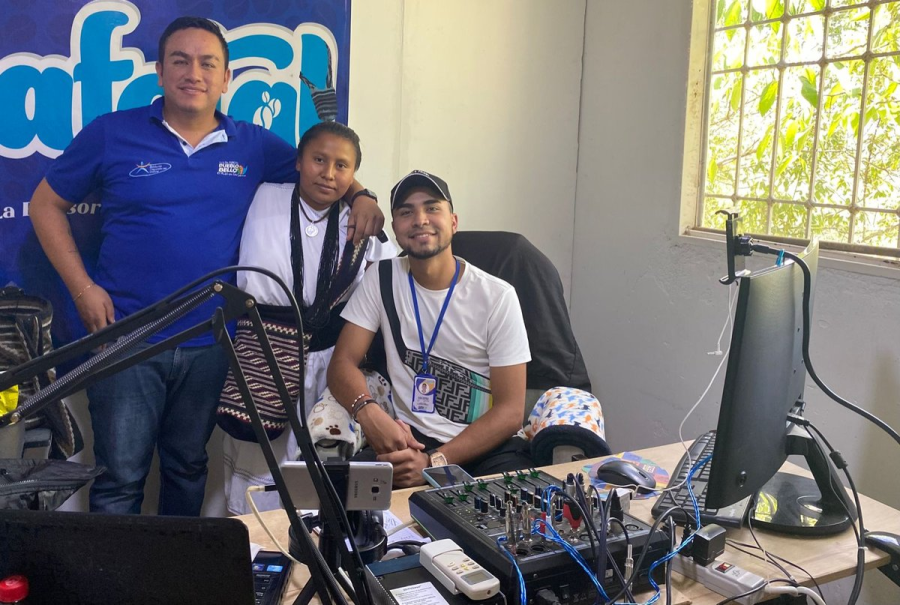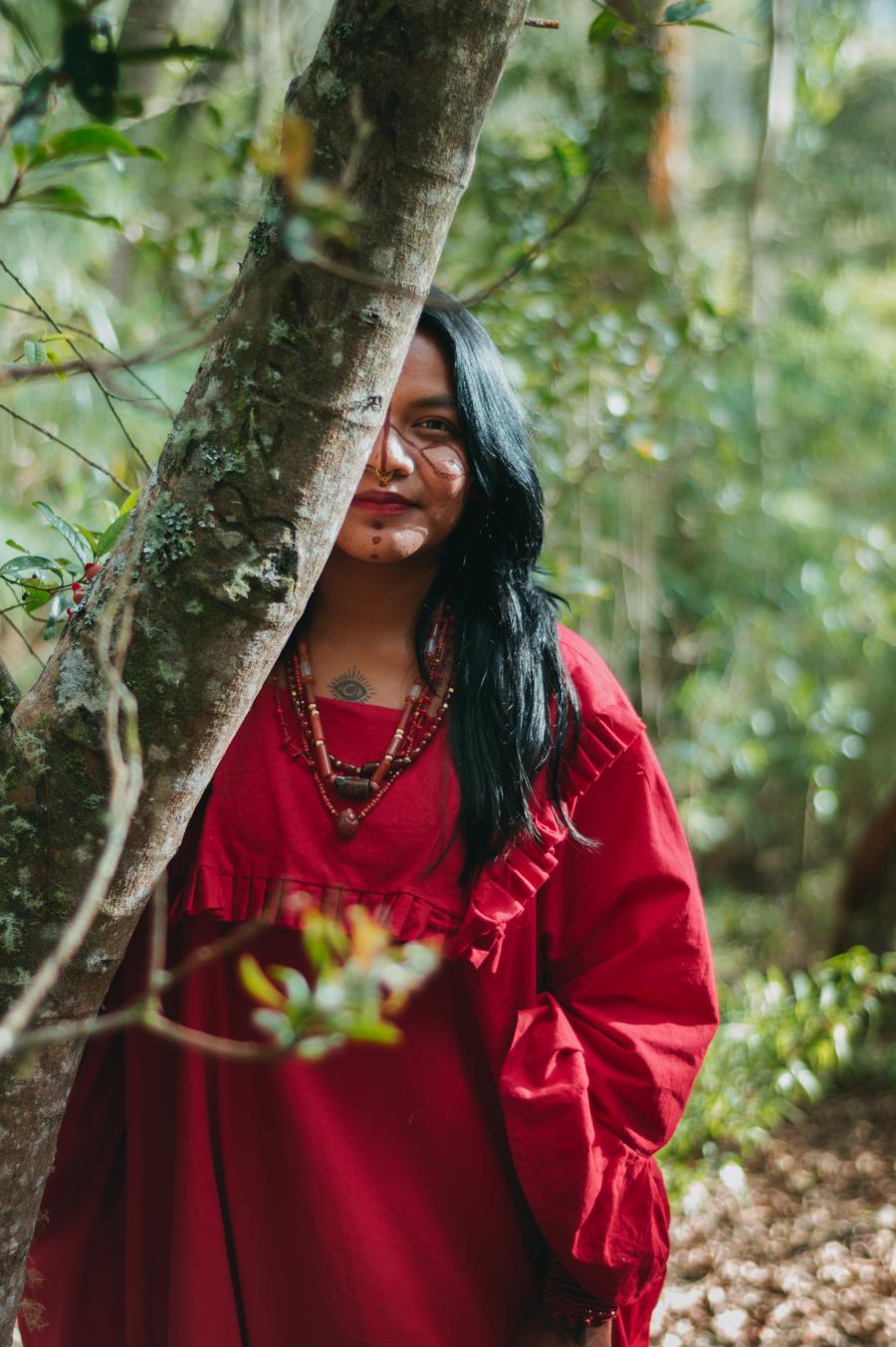At 7:30 on a Friday evening in the overcrowded offices of the Colombian Indian organization, CRIC (Consejo Regional Indígena del Cauca), at least 50 people are still hard at work. They are writing journal articles, preparing educational materials and reports and performing other tasks related to the many activities CRIC coordinates from its base in the city of Popayan in southwestern Colombia.
"We have more requests than expertise or resources, so we do everything poorly," says a young man, laughing. The fact is that of the 50 employees who permanently work out of CRIC's central office, at least 30 are highly qualified specialists: 4 lawyers, 3 accountants, 6 agronomists, 7 medical practitioners, 8 bilingual education specialists, a veterinarian and a journalist. Still, the office is understaffed and unable to provide all the services in demand. Moreover, specialists assist and teach, but they do not determine policy. CRIC, like many grassroots organizations, carefully balances the values of outside assistance with internal self-determination and control.
CRIC, an indigenous council in the Department of Cauca, is made up of 56 cabildos (community councils). Cauca, with one of Colombia's highest concentrations of Indians, is located in the mountainous southwestern portion of the country. It is topographically and climatically inhospitable to large-scale agriculture. The original land cover was destroyed by mining and cattle ranching. Its infertile lands and fragile economy stand in vivid contrast to the rich flood plains of the Cauca River in the adjacent department, Valle del Cauca - site of the largest sugar plantations in Colombia.
For generations, the rural poor who inhabited these plains gradually moved further and further into upland frontier areas, onto lands belonging to indigenous populations. The result was intense competition over land that was both scarce and of poor quality. Recently such conflicts have attracted both guerrilla and government counterinsurgency troops, past 15 years, 102 killings of Indians have been reported.(1)
When CRIC was founded in 1971, its goals were to confront immediate problems by demarcating and titling indigenous lands, protecting Indian human rights and promoting Indian culture and education. After 12 years of successful work in these areas, CRIC expanded its priorities to include economic assistance. Its 1984 work plan ranked environmental restoration and production first-order priorities. Since that time. Cultural Survival has supported CRIC's forestry program.
In the three years since these objectives were established, CRIC has made some impressive accomplishments. Two model production efforts are its forest regeneration programs and experimental agricultural stations. Each has an associated educational and training component.
Three tree nurseries, each run by a local cabildo, now supply seedlings to communities that wish to reforest part of their lands. Plots must contain a minimum of 1,000 trees, all native species. The nursery at San Isidro in the Resguardo Quintana, for example, has responded to and carried out nine such reforestation requests in only two years.
Such projects are carried out by community members utilizing simple technologies. Consulting experts conduct an initial training phase in each community and visit the projects at intervals thereafter. Community trainees learn to recognize native species and their qualities, such as growth rates, required growing conditions and economic and environmental uses. Former trainees often teach others to collect, prepare and plant seeds. In addition, CRIC has prepared a simple manual for communities or individuals wishing to practice forest restoration.
The reforestation program is a model for community resource management. Many formerly unskilled community members, trained initially by outside specialists, have become specialists themselves. They improve their skills by attending seminars in Bogotá, and later lend their expertise to other communities. Outside specialists train community members, and then hand down those skills to the community. This process is slow, but it creates a sustainable project, eliminates problematic and costly dependencies and empowers a community with valuable skills.
Community education is an important component of this project. CRIC offers short courses in environmental education at regional meetings as part of an outreach program to present alternative forms of resource management. Their position is that reforestation and conservation offer long-term economic advantages over short-sighted, immediate returns. A principle objective is the protection and restoration of watersheds, many of which have been reduced through deforestation. Shade trees, edible fruits and firewood (now in short supply) are further motives.
The provision of wild game is yet another incentive for local reforestation programs. Researchers have found that large game birds and small mammals are attracted to forest patches as small as 4 ha. Where other such regeneration activities are underway, ecologists predict that "populations of local animals...might be jacked up to commercially exploitable levels".
In such artificially created forests, prospects for sustained resource management are good, providing (1) the patches are large enough, (2) species diversity is high, and (3) gains from conservation are greater than the immediate needs for forest products and their sale.
In Cauca, reforestation is beginning to show results. One experimental farm is located in the indigenous community of Purace, site of a mine explosion in which adjacent areas were burned so extensively that now, 30 years later, some lands remain hard and unproductive. Students from the local Institute Tecnico Agropecuario assist local farmers in preparing organic compost for fertilizer from harvest by-products to enrich Purace's devastated soils. Now, at the Purace farm, eight community groups walk from within a radius of four hours' distance to attend rotating work days in the community. This year, in addition to their forestry work, the communities harvested 10 different food crops and sold surplus in a nearby town.
Training and outreach are important components in all of CRIC's resource management programs. Four years ago trained members of the Indian community of San Isidro were invited by the non-Indian community of La Viuda to assist in reforestation and farming. Today, the members of the farm at La Viuda are outspoken in their appreciation of their indigenous neighbors. They have both a flourishing reforestation program (whose advising technicians continue to be indigenous personnel) and a profitable farm which supplies corn to nearby markets.(2) "Class is a matter for discussion," says the president of CRIC's executive committee, "but problems, and solving them, are matters of urgency."
Notes
(1) Areas of devastating poverty attract both guerrilla groups and government antiguerrilla forces. The central Cauca region has become increasingly militarized in the past several months. As recently as July of this year, 19-year-old Didimo Antonio Piso, a Coconuco of Purace, was arrested by the army and found dead the following week.
(2) CRIC also has several educational publications on agriculture and on indigenous farming methods. For example, the community of Las Delicias de Buenos Aires published the Cartilla de Agricultures in June 1984. CRIC publications can be obtained by writing to them at Apartado Aereo 516, Popayan, Cauca, Colombia.
Article copyright Cultural Survival, Inc.



